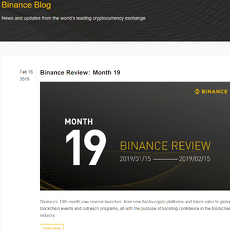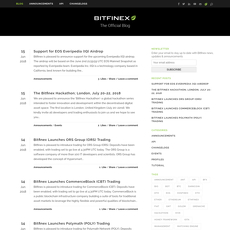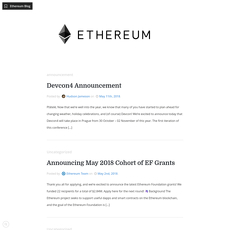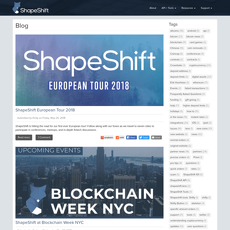Coinspectator Blog Review
Coinspectator Blog
blog.coinspectator.com
Coinspectator Blog Review Guide: Why Crypto Enthusiasts Need Smarter Blogs
Feel like you’re drinking from a firehose every time you try to keep up with crypto news? It’s overwhelming—major Bitcoin swings one minute, meme coins taking off the next, regulations changing overnight, and a hundred new tokens launching before your morning coffee. How on earth are you supposed to spot what really matters for your portfolio (or even just your curiosity) instead of getting lost in all that noise?
But here’s the truth: Not all crypto news sources are created equal. If you’re tired of endless clickbait or feeling like every headline is just another pump-and-dump attempt, you’re not alone. Imagine having a single resource that actually helps you cut through the chaos and gives you real context—not just headlines with wild predictions or shady shills. Wouldn’t you want to find it?
Let’s talk about something different—the Coinspectator Blog. If you’ve ever wondered things like “Is this blog actually worth following?” or “How is it even different from the sea of other crypto sites?”, you’re in the right spot. Here, I’ll show you exactly what makes Coinspectator stand out (or not), how it can change the way you understand crypto news, and what most crypto readers like you are secretly looking for.
Why does the crypto community need quality blogs like Coinspectator?
Look, "keeping up" in crypto isn’t just a hobby anymore—it’s a survival skill. But just scrolling through headlines isn’t enough. There’s a big gap between knowing news is happening versus actually understanding what it means. Most sites barely scratch the surface. Ever come across headlines like:
- “Ethereum breaks $3,500!”
- “A new DeFi protocol goes live”
- “SEC makes new statement on crypto taxation”
But then… no real analysis. No exploration of how this might shake up the altcoin markets, or what the risks and rewards might be.
The real problem with typical crypto news
Let’s be real: most crypto news sites feel like they’re in a race to publish first. It’s all about quick takes—but that means you get:
- Shallow updates that don’t give the “why” behind the story
- Lack of context on regulations or big tech upgrades
- Recycled PR articles or paid posts with biased advice
There was even a 2023 Coindesk study showing that most crypto newsrooms are getting smaller, so deep analysis is often the first thing to go!
The promise of a better solution
Imagine—what if you had a blog that not only told you what’s happening but also explained it like a smart friend would? What if you could finally get:
- Clear, simple breakdowns of complex news
- Opinion pieces that actually have research behind them
- Real stories that help you make smarter crypto moves (not just FOMO in or out!)
That’s the difference between just “news” and usable crypto insights. That’s what well-curated blogs (like Coinspectator) claim to offer—and why they’re getting more attention in the community these days.
What you’ll get from this guide
So, what’s in store ahead?
- A close look at what makes Coinspectator unique
- Why savvy crypto fans should hunt for blogs rather than just news sites
- Key warning signs and green flags for any crypto blog you might check out
- Answers to the biggest questions folks are asking about Coinspectator right now
Curious whether Coinspectator really lives up to the hype or if it’s just another site with flashy headlines? In the next section, I’ll break down exactly what Coinspectator Blog is—and what sort of info you can expect to find there. Ready to see if it could be your new crypto secret weapon?
What is the Coinspectator Blog?
In the wild, never-boring world of crypto, info overload can hit hard. That’s where the Coinspectator Blog comes in. It’s not just an extension of the news aggregator: this is where raw headlines connect with real insights and practical advice. Think of it as your favorite hangout for real crypto talk, straight from the people who actually live and breathe it.
What sort of content does the blog cover?
Ever get tired of scrolling through nothing but price updates and endless FOMO tweets? Coinspectator offers a refreshing mix of content. You’ll find:
- Easy-to-follow explainers—perfect for those “wait, what does that actually mean?” moments
- Unbiased product reviews before you risk any BTC or ETH on the next so-called “game-changer”
- Behind-the-scenes interviews with project founders and industry voices
- Opinion pieces with real perspective—not just parroting the daily hype
- Step-by-step guides that walk you through wallets, DeFi tools, or even privacy basics, like how to stay safe in an airdrop
I’m a sucker for blogs that don’t just repeat the news. For example, Coinspectator once broke down the Ethereum Merge’s impact in detail—no screaming headlines, just a plain-language road map for anyone who wanted to know what it really meant for the ecosystem.
How is Coinspectator different from other crypto blogs?
This isn’t one of those sites churning out keyword-stuffed posts for ad clicks. Coinspectator keeps the tone human and the info actionable:
- No endless bulletins or shilling third-party tokens you’ve never heard of
- Balanced takes after big events (like crashing altcoins or new regulations), helping you get the bigger picture fast
- Variety of voices—so it’s not just one person’s angle repeated a hundred times
“In crypto, clarity beats chaos every time. You’re not here for noise—you want meaning.”
Other blogs often read like they’re written for hedge fund insiders or total beginners—rarely both. Coinspectator somehow threads the needle: accessible enough for newcomers, not dumbed-down for veterans.
Who writes for Coinspectator Blog?
This is the type of blog where you can almost hear the writer’s actual voice—not just a copy-paste from PR emails. The crew is a healthy mix:
- Managed by true crypto geeks who explore protocols for fun
- Supported by industry insiders dropping knowledge you won’t hear on mainstream news
- Mixed in with pro tech writers who make sure everything’s easy to understand
The result? Even the most technical how-to feels doable. You get the vibe that nobody’s trying to talk over your head. No matter if you’re learning about Layer-2 solutions or just curious about what stablecoins actually do, there’s always a friendly angle.
Ever wonder why most crypto blogs feel either too simplistic or so technical they hurt your brain? There’s actually some psychology behind why we crave approachable, trustworthy info—according to a Nielsen Norman Group study, web users trust and remember brands that “talk like a person”, not a robot. Coinspectator nails that balance.
Bet you’re starting to see why I’m a fan. But here’s the burning question—are crypto blogs really that useful, or are they just more noise in the background? Stick around as I break down why the right crypto blogs (and Coinspectator in particular) could be the most powerful tool in your crypto toolkit. Ready to find out? Let’s get into it next.
Why Are Crypto Blogs (Like Coinspectator) So Useful?
Let’s face it: crypto doesn’t make it easy for newcomers or even old-timers to stay ahead. The lingo alone is enough to feel like you’re missing out—or missing something big. Here’s where blogs such as Coinspectator step up, acting as your personal decoder and lookout rolled into one.
Helping newbies break down tough crypto jargon
Ever stared at a crypto chart or whitepaper and felt like it was written in another language? I know that feeling. Crypto blogs like Coinspectator have a knack for taking things like "zero-knowledge proofs", "DeFi yield farming", or "liquid staking" and turning them into plain English. Whether you’re trying to understand the buzz around ETFs or what “Real Yield” really means, these blogs make it simple, so you don’t need a PhD in blockchain just to keep up.
I remember my early days in crypto, getting lost in acronyms and technical explanations. Reading a solid explainer made it all click. As the saying goes, “Complexity is the enemy of execution.” Crypto blogs exist to strip away that complexity.
Keeping you ahead with analysis and forecasts
It’s not just about breaking news. Anyone can tweet a chart or repost headlines. What genuinely keeps you ahead is the analysis—a look at why something happened and what it might mean next. Blogs like Coinspectator often break down:
- The story behind today’s market moves
- What new regulations could mean for your portfolio
- Why some meme coin is actually gathering steam (or maybe not!)
One article I read mapped out past Bitcoin halving cycles and explained, step by step, what that could signal this year. Those are the insights that help you make decisions, not just react to hype.
Used by companies and the community
It’s not just individuals who count on quality crypto blogs. Projects and companies use them to keep their users updated, share roadmaps, and even clear up FUD (Fear, Uncertainty, Doubt). A reliable blog post can build trust with users and spark healthy discussion—ask anyone in the Cardano or Ethereum communities how much a straightforward dev update matters!
It’s no secret that a well-maintained blog can boost a project’s image. According to a Content Marketing Institute study, over 68% of tech consumers trust official blogs for updates and decisions. People want info they can count on, not just flashy launches or empty promises.
Education and product reviews
If you’ve ever been burned by a dodgy wallet or shady token, you know how much an honest review matters. What I love about blogs like Coinspectator is they mix practical guides with hands-on product reviews. Wondering if that hot new hardware wallet is actually easy to set up? Coinspectator has probably already walked through the steps. Thinking about trying a staking platform? Their how-tos and reviews help you dodge headaches while learning.
- Step-by-step guides for newbies
- Advanced walkthroughs for pros
- Honest, hype-free product breakdowns
“In a world drowning in information, the rarest thing is clarity.”
If you’ve ever wondered, “Is this blog actually worth my trust?” or “What makes one blog better than another?”—stick around. There’s an art to spotting the good from the bad, so let’s break that down next…
How to Judge a Good Crypto Blog: Factors to Consider Before Trusting Any Site
There are thousands of crypto blogs out there, but trust me, most are a waste of time or, worse—dangerous to your wallet. So whenever you're thinking about following a new source for your crypto updates, I always suggest looking out for some key signs that separate a real gem from a dud. Here’s my no-nonsense approach to judging if a crypto blog is worth even a single minute of your attention.
Content quality: clear, readable, and well-researched
Your first sniff-test is the writing itself. If you spot typos everywhere, wild claims without any sources, or a heap of technical mumbo jumbo with zero explanation, it’s a red flag. High-quality blogs feel like the author actually cares about what you learn—not just about hitting a word count.
- If you read about a new altcoin and there’s no link to the project or references to credible sources, walk away.
- Solid blogs mention real-world data and news, and ideally, give you external links for fact-checking.
"The details are not the details. They make the design." — Charles Eames
And in crypto, skipping the details can cost you big time.
Specialization vs. variety
A blog that's all over the map—covering NFTs one day, then sports betting, then some random token with zero context—can leave you more confused than informed. I personally prefer blogs that either offer a rich variety with a clear focus or go deep into one area where they actually know their stuff. Ask yourself: Are you getting value with every click, or scattered headlines that don’t help your crypto journey?
Beginner-friendliness and accessibility
Crypto is full of confusing terms and weird tech jargon. If a blog leaves you scratching your head or reaching for a dictionary every five seconds, it’s missing the point. Quality blogs break complex topics into bite-sized, conversational pieces. Look for content that welcomes your questions and doesn’t punish you for not being a blockchain developer.
Language support
Crypto’s global—but English isn’t everyone’s first language. I always check if a blog offers translations or is planning to. Multi-language support shows they care about the wider community. Bonus points if users can select their region or preferred language—just makes life easier.
User experience: design, ads, and mobile
Ever run into a blog that feels like Vegas at midnight? Flashing banners, intrusive pop-ups, twenty tabs suddenly opening up? That’s not just annoying; it distracts you from the important stuff. I put a lot of weight on:
- Fast load times and mobile-friendly layouts. (Over 60% of people read crypto news on their phones—don’t settle for broken pages.)
- Minimal ads—if the news is buried behind “You’ve won a free iPhone!” pop-ups, you’re in the wrong place.
Integrity and reputation
Let’s get real: crypto is wild, and not every site reporting on it has your best interests in mind. When I size up a blog, I look up who’s behind it. Are the writers respected on Twitter, Reddit, or Bitcointalk? Or do they pop up only when a certain coin needs shilling?
You can even search the blog's name + “scam” or check forums for user reviews. Many times, you’ll find out fast if something shady’s going on.
Update frequency
Crypto doesn’t sleep, so neither should the news. If a blog hasn’t posted a fresh story or guide in weeks (or worse, months), it’s not a resource you can count on for timely info. I often find the best blogs update at least a few times a week, sometimes daily.
Ever noticed how the best crypto finds happen when you least expect it? There’s a trick to picking out platforms that consistently deliver. Want to know how I separated the champions from the pretenders… and why only a select few—like the next one—made the cut? Wait till you see what’s up next.
Coinspectator Blog on Cryptolinks: How and Why I Added It
Finding quality in the crypto blog world isn’t just about what pops up first on Google or who shouts the loudest on Twitter. I’m always on the hunt for crypto resources that are actually useful for regular people, not just industry insiders. That’s why I take my selection process seriously, combing through each blog to see what makes it stand out from the noise. When Coinspectator came across my radar, it checked off more boxes than most.
The Selection Process at Cryptolinks
I don’t just add a site because it “looks nice” or has a popular name. Each crypto blog I recommend has to pass my own set of criteria. Here’s a snapshot of how I do it:
- Readability: If a blog post hurts my eyeballs or my brain, it’s an instant “no.” I look for content that’s clear, to-the-point, and easy to follow—think everyday English, not rocket science.
- Originality: I double-check for recycled articles and generic hype. Coinspectator, for example, brings fresh takes and original reporting, not just rehashed PR press releases.
- Expertise: I search for signs that the authors actually know what they’re talking about—insider angles, genuinely helpful guides, and opinion pieces that make you think.
- Mobile Design: If I can’t read a blog on my phone without zooming in or dodging endless pop-ups, I move on. Coinspectator is smooth on both desktop and mobile—huge plus.
- Beginner-Friendliness: I’m always asking—would a newcomer understand this, or would they leave more confused than before?
- Update Frequency: I check the timestamps. Outdated info doesn’t cut it. Fast-moving news matters in crypto, so active blogs get extra points.
Where Coinspectator Stands Out
Here’s what set Coinspectator apart for me:
- Clarity First: Every article gets straight to the point. You won’t waste time wading through fluff or endless jargon. It’s readable, even if you don’t live and breathe crypto Twitter.
- Genuine Coverage Over Clickbait: No “You Won’t Believe This Altcoin!” headlines—just honest, balanced reporting and opinion pieces. Whether it’s a quick news update or a feature explaining a regulation change, you’ll find a practical takeaway.
- Educational Content Mixed In: Alongside trending stories, Coinspectator drops guides and explainers that are actually useful. I’ve seen newbies in the comment section thank them for making sense of a confusing process—always a great sign.
- Diverse Voices: The writing crew ranges from crypto veterans to emerging analysts. This variety keeps the tone friendly and relatable, with different perspectives, instead of a single dry voice.
A recent example: Their coverage of Ethereum upgrades didn’t just report “The Merge happened.” They laid out what it means for gas fees, investor strategy, and upcoming DeFi changes—breaking it into actionable info rather than tech overkill. Studies show that readers retain and act on news better when context is provided, rather than just headline dumps, and that’s exactly what Coinspectator delivers.
Where to Find Coinspectator and Similar Resources
If you want to see how Coinspectator stacks up yourself, it’s live on my top crypto blogs list—alongside 34 other sites that made the cut for legit content, no-nonsense analysis, and real usability. Feel free to hop over, explore a few different voices, and bookmark the ones with styles that resonate with you.
Remember, crypto changes fast, and the best way to spot opportunities (or red flags) is by plugging into reputable sources like these. Thousands of users already trust the list to shortcut their research time—and you won’t find any fluff.
Ever wondered if coinspectator (or the blogs on my list) are truly trustworthy, or what kind of news they actually deliver? Keep going—because in the next part, I’ll reveal some of the most-asked questions about Coinspectator and crypto blogs, and share exactly what you should expect as a reader.
FAQ About Coinspectator Blog and Crypto Blogs in General
If you’ve gotten this far, you probably still have a few burning questions bouncing around in your head. Totally normal. Crypto moves fast, but good answers shouldn’t be hard to find. Here’s a breakdown of the things people ask me most often about Coinspectator Blog—and the world of crypto blogs in general.
Is Coinspectator Blog safe and trustworthy?
This is by far the top question I get, and with good reason. Trust matters—especially with so many anonymous sources out there. Based on everything I’ve seen, Coinspectator Blog is solid. It’s not a fly-by-night operation; it’s got legit writers and editors who’ve been around a while, and I found zero red flags like fake profiles or sock-puppet comment sections. Of course, it’s always smart to double-check news before moving your portfolio, but Coinspectator’s reputation is clean. And remember, transparency is a strong sign—if a blog explains who’s writing the posts and where the info comes from, that’s a big green flag.
What kind of news will I get from Coinspectator compared to other sites?
You’re not just getting endless price updates or press releases. Coinspectator mixes in:
- Market news—so you see the latest moves, but also understand why they matter.
- Feature stories and interviews—think stories about real people, founders, and teams pushing blockchain forward.
- Opinion posts—solid takes on industry trends (without the usual hype).
- Guides, reviews, and how-tos—helpful stuff whether you're just starting out or looking to fine-tune your trading strategy.
For example, I recently saw a beginner’s walkthrough on setting up a hardware wallet—step by step, screenshots included. This isn’t the kind of hand-holding you often find on bigger “news only” crypto outlets. You actually pick up practical skills, not just random buzzwords.
Is Coinspectator good for crypto beginners?
Yes, totally. Most crypto news sites either go too shallow (just recycled PRs) or way too deep (think: tech whitepapers and incomprehensible code snippets). Coinspectator hits the sweet spot. I saw a jargon buster article that actually explained what a token bridge is, using examples you’d tell your non-crypto friends. If you’re new to the space, you won’t feel lost here. And if you’re a long-term holder, you’ll find enough detail to keep things interesting. The feedback I’ve seen on Reddit and Twitter backs this up—lots of beginners say they started there before graduating to bigger risk-and-reward moves.
Final thoughts: Should you bookmark Coinspectator Blog?
If you’re into crypto, you should absolutely have a handful of reliable, balanced sources bookmarked. Coinspectator stands out because it doesn’t try to scare you with FOMO or drown you in technical lingo. It’s one of those rare blogs that keeps up with trends without feeling like you’re reading a press release factory. Real news, real takes, and a real community vibe. That’s exactly why so many in the crypto scene—including newbies and pros—keep coming back.
At the end of the day, no blog knows it all. But if you’re looking for a source you can actually trust (and learn from), give Coinspectator a shot. When it comes to keeping your crypto knowledge sharp, it’s a bookmark I think you’ll find yourself using more often than not.













